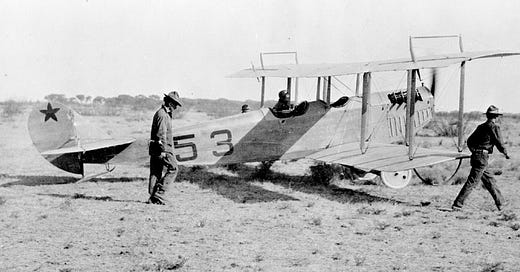History's Echo: The US-Mexico Border Then and Now
From Pancho Villa to Drug Cartels: Similar Challenges, New Technology
When U.S. border agents launch drones to patrol the Mexican border today, they're following in surprising footsteps: those of a young Army captain who crashed nine rickety planes in 1916. Both stories are part of a larger pattern that keeps repeating at the border, where new technology meets old problems.
Think of the border as a stage where the same play keeps running, just with different actors and upgraded props. A century ago, the villain was Pancho Villa, a Mexican revolutionary who attacked a U.S. town. Today, it's drug cartels sending deadly fentanyl into American communities. The script remains eerily similar: violence spills over the border, America responds with force, and Mexico struggles to handle pressure from both sides.
The tools have changed dramatically, but the story hasn't. In 1916, Lieutenant George Patton – who would later become a famous World War II general – roared through the desert in his private car, chasing Mexican fighters. Today, border patrol agents drive high-tech SUVs equipped with night vision and sensors. It's like upgrading from a flip phone to an iPhone – the technology is far better, but the basic job hasn't changed.
Those first military planes that crashed in 1916 were the great-grandparents of today's border drones. Captain Benjamin Foulois, despite his planes' dramatic failures, saw the future clearly. He wrote about using aircraft with radios to watch the border – exactly what sophisticated U.S. surveillance drones do now, often flying over Mexico in ways that make the Mexican government uncomfortable.
The border has always been a two-way street of problems. Then and now, American guns flow south while illegal goods flow north. Today's Secretary of State Marco Rubio promises to fix this deadly trade, joining a long line of officials who've made similar promises over the decades.
The relationship between the two countries remains unbalanced, like a see-saw with a grown-up on one end and a child on the other. In 1916, America sent 10,000 troops deep into Mexico without really asking permission. Today, U.S. surveillance planes cross the border while Mexico faces a tough choice: accept it or risk damaging relations with its powerful neighbor.
A former Mexican president once said something that still rings true: "Poor Mexico, so far from God and so close to the United States." Today's Mexican government faces the same tough spot as its ancestors – caught between powerful drug cartels it struggles to control and an frustrated U.S. government demanding action.
What's the lesson in all this? Better technology – from Patton's early cars to today's drones – changes how things work but not the basic problems. The U.S. still has more power, illegal goods still cross both ways, Mexico still struggles to control its territory, and America still acts freely along the border.
Real solutions need to dig deeper than new gadgets. They need to address why Americans buy so many drugs, why American guns keep heading south, why Mexico struggles to govern some areas, and why illegal business is so profitable along the border. Until these basic problems change, we might spend the next hundred years watching the same border story play out – just with fancier equipment and the same human cost.
A Spanish version of this article appeared in El Debate, Madrid, on Feb 20, 2024 https://www.eldebate.com/internacional/20250220/cuando-historia-repite-desafios-fronterizos-estados-unidos-mexico-antes-ahora_271126.html






Interesting historical comment Alfredo. I'm struck you didn't go back a bit further in time, to the Mexican-American war, which Lincoln and Grant (at the time and later too) opposed as a massive fraud perpetrated on a weaker neighbor. We got some good land from it though, including Texas and my home state of California, and paid for it to make ourselves feel better.
I always appreciated the Mexican American writer Richard Rodriquez back in the day (this was in the late 80s and early 90s) describing immigration to the United States from Mexico (and other parts of Latin America) as "La reconquista". Since the Yankees stole the land in the first place with a fraudulent war, the Mexicans would take it back slowly, stealthily, by immigration. Are we trying to halt an inexorable tide?